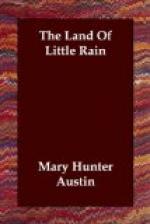No burrower is so unwise as not to have several exits from his dwelling under protecting shrubs. When the badger goes down, as many of the furry people as are not caught napping come up by the back doors, and the hawks make short work of them. I suspect that the crows get nothing but the gratification of curiosity and the pickings of some secret store of seeds unearthed by the badger. Once the excavation begins they walk about expectantly, but the little gray hawks beat slow circles about the doors of exit, and are wiser in their generation, though they do not look it.
There are always solitary hawks sailing above the mesa, and where some blue tower of silence lifts out of the neighboring range, an eagle hanging dizzily, and always buzzards high up in the thin, translucent air making a merry-go-round. Between the coyote and the birds of carrion the mesa is kept clear of miserable dead.
The wind, too, is a besom over the treeless spaces, whisking new sand over the litter of the scant-leaved shrubs, and the little doorways of the burrowers are as trim as city fronts. It takes man to leave unsightly scars on the face of the earth. Here on the mesa the abandoned campoodies of the Paiutes are spots of desolation long after the wattles of the huts have warped in the brush heaps. The campoodies are near the watercourses, but never in the swale of the stream. The Paiute seeks rising ground, depending on air and sun for purification of his dwelling, and when it becomes wholly untenable, moves.
A campoodie at noontime, when there is no smoke rising and no stir of life, resembles nothing so much as a collection of prodigious wasps’ nests. The huts are squat and brown and chimneyless, facing east, and the inhabitants have the faculty of quail for making themselves scarce in the underbrush at the approach of strangers. But they are really not often at home during midday, only the blind and incompetent left to keep the camp. These are working hours, and all across the mesa one sees the women whisking seeds of chia into their spoon-shaped baskets, these emptied again into the huge conical carriers, supported on the shoulders by a leather band about the forehead.
Mornings and late afternoons one meets the men singly and afoot on unguessable errands, or riding shaggy, browbeaten ponies, with game slung across the saddle-bows. This might be deer or even antelope, rabbits, or, very far south towards Shoshone Land, lizards.
There are myriads of lizards on the mesa, little gray darts, or larger salmon-sided ones that may be found swallowing their skins in the safety of a prickle-bush in early spring. Now and then a palm’s breadth of the trail gathers itself together and scurries off with a little rustle under the brush, to resolve itself into sand again. This is pure witchcraft. If you succeed in catching it in transit, it loses its power and becomes a flat, horned, toad-like creature, horrid looking and harmless, of the color of the soil; and the curio dealer will give you two bits for it, to stuff.




